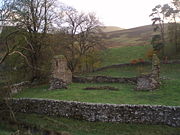
Kilbucho
Encyclopedia

Scottish Borders
The Scottish Borders is one of 32 local government council areas of Scotland. It is bordered by Dumfries and Galloway in the west, South Lanarkshire and West Lothian in the north west, City of Edinburgh, East Lothian, Midlothian to the north; and the non-metropolitan counties of Northumberland...
area of Scotland
Scotland
Scotland is a country that is part of the United Kingdom. Occupying the northern third of the island of Great Britain, it shares a border with England to the south and is bounded by the North Sea to the east, the Atlantic Ocean to the north and west, and the North Channel and Irish Sea to the...
in Peeblesshire
Peeblesshire
Peeblesshire , the County of Peebles or Tweeddale was a county of Scotland. Its main town was Peebles, and it bordered Midlothian to the north, Selkirkshire to the east, Dumfriesshire to the south, and Lanarkshire to the west.After the local government reorganisation of 1975 the use of the name...
and near Biggar
Biggar, South Lanarkshire
Biggar is a town and former burgh in South Lanarkshire, Scotland. It is situated in the Southern Uplands, near the River Clyde, around 30 miles from Edinburgh along the A702. The closest towns are Lanark and Peebles, and as such Biggar serves a wide rural area...
and Broughton.
The name derives from the church which was dedicated to St Bega an Irish abbess. Several monasteries were dedicated to St Bega, many in Cumbria
Cumbria
Cumbria , is a non-metropolitan county in North West England. The county and Cumbria County Council, its local authority, came into existence in 1974 after the passage of the Local Government Act 1972. Cumbria's largest settlement and county town is Carlisle. It consists of six districts, and in...
including St Bees
St Bees
St Bees is a village and civil parish in the Copeland district of Cumbria, in the North of England, about five miles west southwest of Whitehaven. The parish had a population of 1,717 according to the 2001 census. Within the parish is St...
but also in Scotland at Kilbagie in Clackmannanshire and Kilbegie in Argyllshire. Near the church is St Bees well
Kilbucho is "fenced" in by hills on three sides, including some of the highest in southern Scotland east of Galloway
Galloway
Galloway is an area in southwestern Scotland. It usually refers to the former counties of Wigtownshire and Kirkcudbrightshire...
. Coulter Fell is near here.
The area is strongly connected with John Buchan, the author of The Thirty Nine Steps
The Thirty-nine Steps
The Thirty-Nine Steps is an adventure novel by the Scottish author John Buchan. It first appeared as a serial in Blackwood's Magazine in August and September 1915 before being published in book form in October that year by William Blackwood and Sons, Edinburgh...
and former governor general of Canada
Canada
Canada is a North American country consisting of ten provinces and three territories. Located in the northern part of the continent, it extends from the Atlantic Ocean in the east to the Pacific Ocean in the west, and northward into the Arctic Ocean...
. It is thought that the inspiration for his 1927 novel Witch Wood
Witch Wood
Witch Wood is a 1927 novel written by the Scottish author and politician John Buchan. Set in the 17th century, it revolves around a group of witches, and according to the historian Ronald Hutton, was based upon the Witch-cult hypothesis of the anthropologist Margaret Murray...
comes from this particular area.

